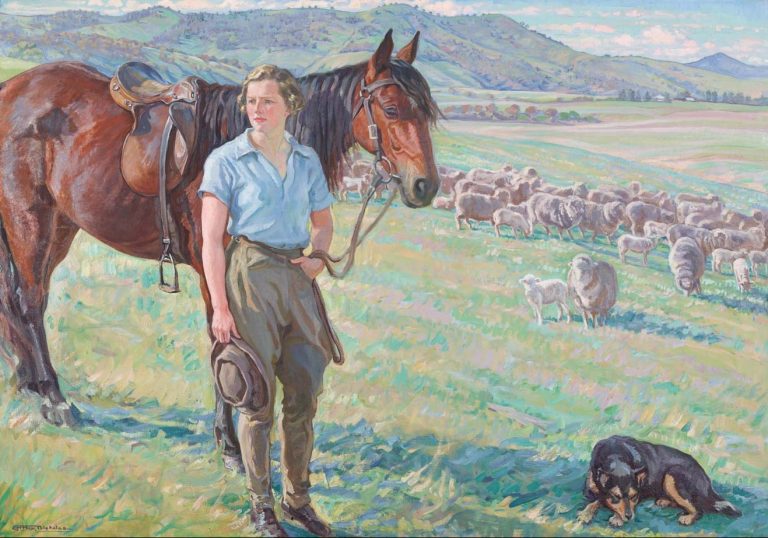We acknowledge the Traditional Owners of the land on which the Queensland Art Gallery | Gallery of Modern Art stands and recognise the creative contribution First Australians make to the art and culture of this country.

Hilda Rix Nicholas / Australia 1884–1961 / The fair musterer 1935 / Oil on canvas / 102.3 x 160.4cm / Purchased 1971 / Collection: Queensland Art Gallery | Gallery of Modern Art / © QAGOMA
Hilda Rix NicholasThe fair musterer 1935
On Display: QAG, Gallery 10
Dressed in jodhpurs, a short-sleeved shirt and riding boots, Hilda Rix Nicholas’s ‘fair musterer’ is ready for the day’s work. Her nonchalant pose is easy, confident and self-assured; it suggests that she is both an accomplished horsewoman and a capable bushworker, a woman who actively participates in the life of rural Australia.
Painted during the spring of 1935 not far from Rix Nicholas’s studio at Knockalong in southern New South Wales, The fair musterer is one of Rix Nicholas’s largest and most important pictures. The model was Nance Edgley, her son’s first governess who worked at Knockalong during 1934 and 1935. One of the artist’s favourite views of the Tombong Range and the neighbouring property of Tombong can be seen in the distance.
In the 1930s and 1940s Rix Nicholas explored the theme of women in the bush, painting a number of pictures, such as The fair musterer, which used the bush as a site for female achievement. The women avow the artist’s own status as a legitimate bushwoman. The ‘fair musterer’ can ride, muster sheep and do a man’s job, although she does not deny her womanliness. Her costume, for instance, is typical of the kind of dress worn by women working on the land at this time. It clearly denotes her gender, but also suggests that she has assumed a new kind of femininity.
Endnotes:
Edited extract from John Pigot, ‘A National Heroine: Hilda Rix Nicholas: The fair musterer’ in Lynne Seear and Julie Ewington (eds). Brought to Light: Australian Art 1850-1965, Queensland Art Gallery, 1998
Hilda Rix Nicholas was born in Ballarat in 1884. Her father, Henry Finch Rix, was a teacher, later working for the Victorian Education Department, while her mother Elizabeth was a talented amateur painter.
Hilda Rix studied at the Melbourne National Gallery School under Frederick McCubbin. Arthur Streeton was a family friend and it is thought that he encouraged her to study in Europe. She left Melbourne in March 1907 to study in London and Paris. Following a period of tragedy and loss during her family’s evacuation to London at the outbreak of the First World War, the artist returned to Australia in 1918. She travelled widely throughout New South Wales and visited Queensland in 1927 on a painting expedition.
Boldness, strength and honesty are characteristic of Hilda Rix Nicholas’s work. Her response to landscape was intense while her still lifes and interiors have an intimacy reminiscent of Dutch interiors.
Discussion Questions
1. Look closely at the painting. What type of place do you think this is and what elements of the painting help us understand this?
2. What do you think a ‘musterer’ does? Can you think of some other examples of jobs or activities that involve working with animals?
3. Which sections of painting do you think have the most detail? (Hint: look closely at the background and compare this to the elements that are in the foreground closest to you)
Activities
1. Draw a picture of your favourite place. Think about what animals you would include in your drawing to represent where you are. For example, you might draw birds if you are in the bush or fish if you are by the beach. Include yourself in the picture and give your artwork a title.
2. The person in this painting is someone the artist knew — her son’s governess Nancy. Create a drawing or painting of someone you know. Think about how you would represent them — where would they be and what would they be doing?
3. Imagine you are standing in this painting, on the opposite side of the field, looking towards the horse and the musterer. Create a drawing from this perspective.